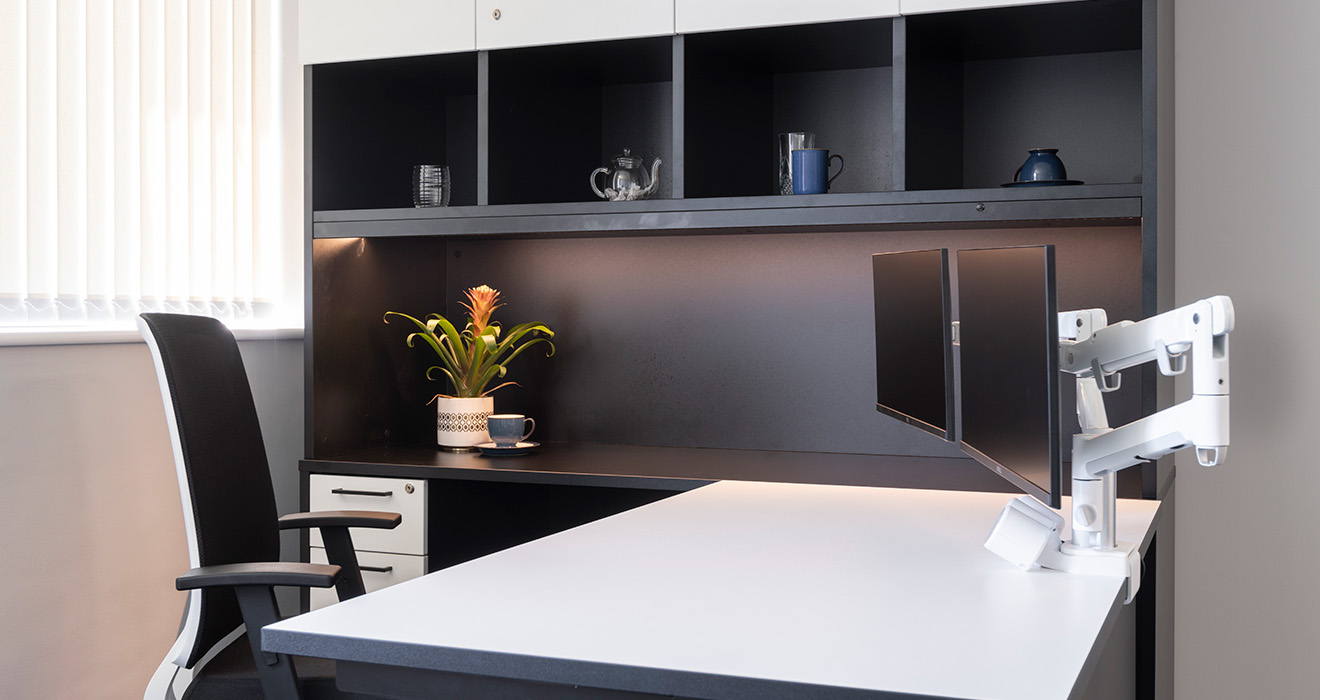Importance of desk material and construction to monitor arm performance

Understanding Monitor Arms and Mounts
Properly mounted monitors enable users to position them for optimal viewing, including at sit-to-stand workstations in multi-tenant hot desk environments. Monitor arms provide benefits including improved ergonomics, reduced neck and eye strain, and enhanced desk space utilisation. To fully harness these advantages, it's crucial to choose a desk that complements your monitor arm or mount.
The Impact of Desk Material
Stability
Desk material significantly influences the stability of your monitor setup. Solid, heavy desks made from materials like hardwood or steel are generally more stable and can support the weight of multiple monitors without wobbling.
Particleboard and MDF are compatible with clamps but may not provide the same level of stability if they are lightweight or poorly constructed. Lightweight desktops constructed with paper honeycomb in laminated particleboard are likely to compress when clamped. See David Zhang's teardown of an IKEA Linnmon desk, for what the inside of such a desk looks like.
Mounting Options
The type of desk material affects suitable mounting options – see Atdec’s clamp options. Wooden desks typically allow direct clamping of monitor arms, or grommet and bolt-through. Metal desks suit clamps so long as (like Atdec) the clamp has friction adhesive. Glass and special material desks most likely require alternatives like a wall mount or freestanding foot.
Vibration Absorption
Some materials, such as solid wood, absorb vibrations better than others. This can be important if you're using your desk for tasks that create vibrations, like typing on a mechanical keyboard or using a powerful subwoofer – this is seen particularly with gamer setups. A desk that absorbs vibrations help maintain stable monitor positioning even where mechanical keyboards and heavy base are in use.
The Impact of Desk Construction
Thickness
The thickness of your desk can affect the installation of monitor arms and mounts. Thicker desks generally provide more stability and allow for secure mounting, while thinner desks may require additional reinforcement or support plates.
|
Atdec fixings |
Supported desk thickness |
|
AWM-FB bolt through kit |
to 33mm (1.3”) |
|
AWM-FC c-clamp |
18 to 33mm (0.71 to 1.3”) |
|
AWM-FF f-clamp |
to 79mm (3.11”) |
|
AWM-FH heavy duty clamp |
to 68mm (2.68”) |
|
AC-GC grommet clamp |
18 to 36mm (0.71to 1.42”) |
Frame Design
Desks with reinforced or sturdy frames offer better support for monitor arms. The frame's design should allow for easy attachment of mounting brackets or clamps.
Desk edges
Bevelled desktop edges reduce the clamp-desk surface area, thereby negatively affecting the connection strength.
Adjustability
Consider whether your desk's construction allows for height and tilt adjustments. Some desks come with built-in height-adjustable legs, making it easier to achieve a stable desk and ergonomic monitor setup.
Assessing Your Desk's Suitability for Monitor Arms
Now that we've discussed how desk material and construction can impact monitor arm performance, let's explore how to determine if your current desk is a suitable choice for using a monitor arm:
Desk Weight and Stability
Check the overall weight and stability of your desk. If it feels stable and does not wobble when you type or touch the monitors, it's a good sign. Solid wood or steel desks are generally excellent choices in this regard.
Composite materials like MDF exhibit different characteristics than wood. Some composites may compress when clamped and provide an unstable mount, particularly with heavy monitors. Laminate-covered paper honeycomb desks will not provide the same degree of stability as stronger materials.
Mounting Options
Examine your desk's surface for potential mounting points. Wooden desks usually allow for direct attachment, metal surfaces a clamp style, and glass tops require a freestanding mount. Ensure the desk can accommodate the mounting method of your chosen monitor arm or mount.
Thickness and Reinforcement
Measure the thickness of your desk's surface and assess whether it's thick enough to securely hold a monitor arm or mount. If it's thin, consider adding reinforcement plates or choosing a different desk.
Be mindful that desktops constructed of MDF and other composites are frequently hollow. Hollow desks will not provide the same degree of support as solid.
Frame Design
Look at the desk's frame and check for attachment points or features that can accommodate monitor arms or mounts. A sturdy frame will provide better support.
Ergonomics
Consider whether your desk allows for proper ergonomic adjustments, such as height and tilt. If not, you may need to invest in a monitor arm with these capabilities or choose a desk with adjustable legs.
Selecting the right desk for your monitor arm or mount is essential to create a comfortable and efficient workspace. Desk material and construction significantly impact stability, mounting options, and overall performance. When choosing a desk, prioritize stability, compatibility with your mounting method, and the ability to make ergonomic adjustments. By doing so, you'll ensure a harmonious setup that enhances your productivity and well-being while using multiple monitors.



